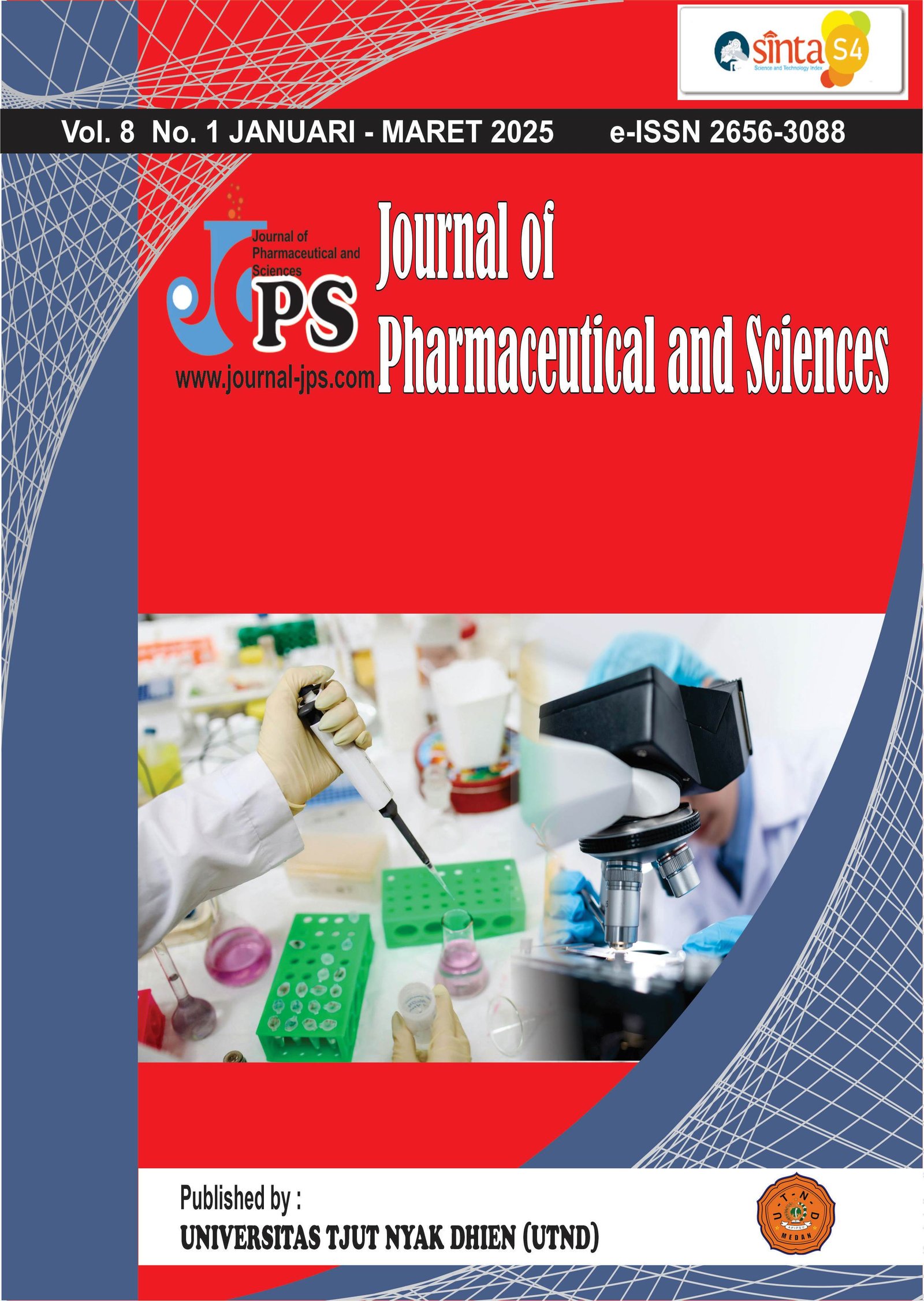Formulation of taro leaf stem juice ointment (Colocasia esculenta L.) schoot for healing cut wounds in male white rats (Rattus norvegicus)
Main Article Content
Page: 187-195
Abstract
Introduction: Taro contains several compounds that can accelerate wound healing, such as flavonoids, phenols, and saponins. These compounds act as natural antibiotics, cleansing wounds with their antibacterial and antifungal properties. Therefore, this plant can aid in the wound healing process. Tannins, on the other hand, have the ability to constrict blood vessels and reduce bleeding in the wound area, decrease infection, and aid in wound healing during the inflammatory phase. One of the wound healing factors, vitamin C helps strengthen the walls of blood vessels, especially in the injured area, to maintain blood supply there and assist in accelerating collagen synthesis during the wound healing process. Lectin, a substance that can accelerate wound closure by aiding better cell regeneration. Arecaceae plants have many benefits for society, such as being used as a food source by harvesting their tubers, or being used as ornamental plants that beautify yards. Taro is also used as medicine both internally and externally. Almost all parts of the taro plant are processed into medicines, and the tubers, stem bark, and roots are crushed and then applied to the skin to heal wounds or bruises. Objective: This study aims to determine the wound healing effects of the sap from the taro stem (Colocasia esculenta L) Schott on male rats (Rattus norvegicus). Method: This study uses an experimental method, which includes sampling, preparation of taro leaf stem extract with concentrations of 2%, 4%, 6%, ointment evaluation test, and incision wound healing activity test on white rats grouped into 5 groups, each consisting of 3 rats. Statistical analysis includes one-way ANOVA to see if there is a significant difference between concentrations in the healing of incisional wounds in male white rats. Result: The research conducted shows that F1 (2% concentration) can heal the rats on the 10th day. F2 (4% concentration) the rats healed on the 8th day, F3 (6% concentration) the cut wounds healed on the 7th day, positive control (Betadine ointment) all rats healed on the 7th day. Conclusion: The extract of taro leaf stems (Colocasia esculenta L) Schoot can be formulated into an ointment preparation for the healing of incised wounds in male white rats (Rattus norvegicus), with the most effective concentration being 6% because it can heal incised wounds the fastest among the other concentrations.
Downloads
Article Details

This work is licensed under a Creative Commons Attribution-NonCommercial-ShareAlike 4.0 International License.
References
Wahyuni W, Wahid H, Febriana R. Formulasi Krim Ekstrak Etanol Tangkai Daun Talas(Colocasia esculenta L.) Terhadap Luka Sayat Pada Tikus Putih (Rattus norvegicus) Galur Wistar. J Kesehat Tambusai. 2022;3(3):338–47. DOI: https://doi.org/10.31004/jkt.v3i3.5721
Wijaya BA, Citraningtyas G, Wehantouw F. Potensi Ekstrak Etanol Tangkai Daun Talas (Colocasia esculenta [L]) Sebagai Alternatif Obat Luka Pada Kulit Kelinci (Oryctolagus Cuniculus). Pharmacon J Ilm Farm. 2014;3(3):211–9.
Oktaviani DJ, Widiyastuti S, Maharani DA, Amalia AN, Ishak AM, Zuhrotun A. Review: Bahan Alami Penyembuh Luka. Farmasetika.Com (Online). 2019;4(3):44. DOI: https://doi.org/10.24198/farmasetika.v4i3.22939
Sukmawati E. Faktor - Faktor Yang Berhubungan Dengan Proses Penyembuhan Luka Post Sectio Caesaria. J Econ Bus Account Ventur. 2018;21(10):1–9. DOI: https://doi.org/10.14414/jebav.v21i10.1122
Adriana E, Kardhinata Eh, Hanafiah Ds. Inventarisasi Dan Identifikasi Jenis Tanaman Talas-Talasan Dari Genus Colocasia Dan Xanthosoma Di Kabupaten Deli Serdang dan Serdang Bedaga. J Agroekoteknologi. 2019;7(1,Jan):46–54.
Andri, M, Sihombing D. Efektivitas sediaan salep yang mengandung ekstrak ikan gabus (Channa striata) pada proses penyembuhan luka akut stadium II terbuka pada tikus jantan galur wistarRats. Pharm Sci Res. 2018;4(2):4. DOI: https://doi.org/10.7454/psr.v4i2.3602
Stevanie Elisabeth Davis1, Selvana S. Tulandi Olvie S. Datu1 FSDNP. Formulasi Dan Pengujian Sediaan Salep Ekstrak Etanol Daun Kembang Sepatu (Hibiscus Rosa-Sinensis L.).
Arif MZ. Formulasi Sediaan Salep Ekstrak Etanol Daun Kirinyuh (Euphatorium odoratum L.) sebagai Penyembuh Luka Terbuka pada Kelinci. J Ilm Manuntung. 2016;2(2):224–32. DOI: https://doi.org/10.51352/jim.v2i2.70
Lasut TM, Tiwow G, Tumbel S, Karundeng E. Uji Stabilitas Fisik Sediaan Salep Ekstrak Etanol Daun Nangka Artocarpus heterophyllus Lamk. Biofarmasetikal Trop. 2019;2(1):63–70. DOI: https://doi.org/10.55724/jbiofartrop.v2i1.40
V. E. Kaban, N. Nasri, K. Gurning, H. D. Syahputra, and Z. Rani, “Formulasi Sediaan Lip Cream Ekstrak Daun Miana (Coleus scuatellariodes [L] Benth.) sebagai Pewarna Alami,” INSOLOGI J. Sains Dan Teknol., vol. 1, no. 4, pp. 393–400, 2022. DOI: https://doi.org/10.55123/insologi.v1i4.719
Y. Rasyadi, D. Agustin, G. Aulia, S. Merwanta, and D. Hanifa, “Formulasi lip balm ekstrak etanol bunga kecombrang (Etlingera elatior (jack)) dan uji stabilitas menggunakan metode freeze and thaw,” Parapemikir J. Ilm. Farm., vol. 10, no. 2, pp. 54–61, 2021. DOI: https://doi.org/10.30591/pjif.v10i2.2505
K. W. Sitoastri and R. Hutabarat, “formulasi dan hedonic test (uji kesukaan) sediaan lip cream ekstrak cair natural deep eutectic solvent (nades) buah terong belanda (Solanum betaceum Cav.) sebagai pewarna alami,” Sci. J. Ilm. Sains dan Teknol., vol. 3, no. 1, pp. 820–835, 2024.
N. B. Primadani, R. Alyidrus, N. Farid, and N. Auliah, “Formulasi dan Uji Efektivitas Sediaan Lip cream dari Ekstrak Etanol Biji Buah Merah (Pandanus conoideus L) sebagai Pewarna Alami dengan Menggunakan Metode DPPH (1, 1-Difenil-2-Pikrihidrazil),” JOPS (Journal Pharm. Sci., vol. 7, no. 1, pp. 136–142, 2023. DOI: https://doi.org/10.36341/jops.v7i1.4173
R. N. Santi, E. Herawati, and N. S. S. Ambarwati, “Formulasi dan evaluasi sediaan kosmetik pewarna lipstik dari ekstrak kulit batang secang (Caesalpinia sappan L),” J. Tata Rias, vol. 10, no. 1, pp. 72–82, 2020. DOI: https://doi.org/10.21009/10.1.7.2009





